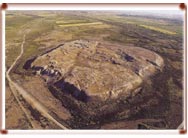Otrar Tobe, Kazakhstan
© UNESCO 2003
National implementing agency: NIPI (Institute for Scientific Research and Planning on Monuments of Material Culture) and Institute of Archaeology
Project duration: 2001-2004
Total project budget: US$ 829, 703
The Otrar Oasis, which covers some 200km2 at the confluence of the Arys and Syr Darya rivers, consists of a largely uninhabited and unspoiled landscape containing the remains of six mediaeval towns along with an extensive system of irrigation canals dating back 2,000 years.
These towns, the largest and most important of which is Otrar Tobe, were first excavated in 1969, revealing the spectacular mud-brick remains of large, typically Central Asian settlements including a central citadel, shahristan (or town area), rabat (suburbs), and earthen fortifications and city walls. Unless conservation and safeguarding action is urgently undertaken, these important vestiges of the region's cultural heritage will be lost forever.
The purpose of this project is to conserve the ancient town site of Otrar and to preserve it for future generations. Developing the skills and expertise of Kazakh and Central Asian professionals involved in the safeguarding and conservation of cultural her-itage is also emphasized, notably through the conservation of Otrar's mud-brick and earth structures, which are in danger of rapid erosion and deterioration.
(Extract from "Preservation of Tangible Cultural Heritage through the UNESCO/Japanese Funds-in-Trust" p.18)
Links:
Latest Publication on the International Cooperation through the UNESCO/Japanese Funds-in-Trust (
pdf, 2.91MB)
Second publication (2003) concerning the Japanese Funds-in-Trust Preservation of Cultural Heritage (
pdf, 2.29MB)
First publication concerning the Japanese Funds-in-Trust Preservation of Cultural Heritage (1998) (
pdf, 5.92MB)
Back to : The Japanese Funds-in-trust for the Preservation of World Cultural Heritage
Legal Matters | About Accessibility | Privacy Policy
Copyright : 2013 Permanent Delegation of Japan to UNESCO
